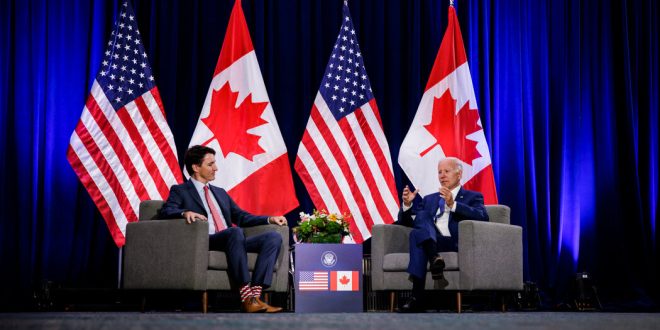OTTAWA — Nearly every day at Roxham Road, people cross over from the United States into the arms of the Canadian police and ask for asylum.
When President Biden arrives in Canada’s capital on Thursday for his first visit to the country since taking the Oval Office, the influx of migrants at that road, an unofficial border crossing on a country lane in Quebec, will be near the top of the agenda for his meetings with Prime Minister Justin Trudeau.
Mr. Trudeau’s government has welcomed refugees from Syria and elsewhere, and has pledged striking increases in immigration to the country, earning Canada a reputation as being more open to migrants than many other Western nations. But over the past year, as migration has swelled at Canada’s border, with a surge of asylum seekers walking into Roxham Road from a sleepy village in New York State, there are signs that Canada’s famed hospitality toward migrants may be fraying.
The surge of nearly 40,000 migrants who crossed into the country last year — more than double the number in 2019 — has given Canada a small taste of the challenges that other Western countries have faced in settling refugees and has prompted Mr. Trudeau’s opponents to call for him to renegotiate a key agreement on asylum seekers with the United States. The number arriving each month has spiked, with almost 5,000 people arriving in January.
Mr. Trudeau has vowed to hammer out changes to the agreement with the United States that his political opponents say is fueling the surge. On Wednesday, Mr. Trudeau suggested that a deal may be announced before Mr. Biden returns to Washington on Friday evening.
“We’ve been working very closely with the Americans for many months, and we hope to have an announcement soon,” he told reporters.
A Canadian government official, who spoke about the talks on the condition that he not be identified, said that the United States was interested in reworking the agreement because it is facing a growing number of people headed the other way, from Canada into the United States.
Under the pact, the Safe Third Country Agreement, which was signed by Canada in 2002, asylum seekers who enter Canada at regular land crossings with the United States can be sent back there immediately. But those who make their way in by simply crossing anywhere else along the 8,890-kilometer border (about 5,517 miles) — the longest land border in the world — can make a claim and remain in Canada until an immigration hearing determines their final status.
(Asylum seekers who come from other countries on planes or by ships are not covered by the agreement regardless of where they enter. They are comparatively few in number and, in many cases, are detained until their hearings.)
But several Canadian immigration and legal experts say that even if changes are made to the agreement, the problem will persist and possibly get worse by pushing the border crossings underground, making them more dangerous. It is also possible that the agreement will ultimately be struck down by a pending ruling from the Supreme Court of Canada, which may, as the Federal Court of Canada has done, declare it a violation of Canada’s Constitution as well as of its obligation to receive refugees under international treaties.
“The Canadian government and the minister of immigration are in a difficult position: The politics of this are such that the government must be seen to be doing something,” said Audrey Macklin, a professor of law at the University of Toronto who studies migration issues. “But they have to know that anything that closes off ways of entering only amounts to a job-creation program for smugglers and a kind of stimulus package for militarizing the border.”
Most migrants who walk into Canada from the United States trudge there by the unofficial crossing from New York State to Roxham Road in Saint-Bernard-de-Lacolle, Quebec. The road’s improbable rise to national prominence started about 2016, ebbed during much of the pandemic and came roaring back about 15 months ago.
Its role as a conduit of migrants stems from what Mr. Trudeau’s political opponents characterize as a loophole in the agreement, a pact that went into effect in 2004 and that came largely at Canada’s request and was part of a wide array of new border measures that followed the Sept. 11 terrorist attacks on the United States.
The steady stream of migrants who come to Roxham Road are met by members of the Royal Canadian Mounted Police who now almost ritualistically warn them that they will be arrested and charged with unlawfully entering Canada.
Those who cross are quickly processed, released from detention and generally bused to Montreal. Not long afterward, they are allowed to work and receive health care and other social benefits while they wait for their applications to be processed. Many are placed in hotels or other accommodations at government expense, and their children attend public schools.
François Legault, the premier of Quebec, has complained that the surge is overwhelming his province. And many of the people now coming across are being sent to other provinces, particularly Ontario.
Political opponents, including Mr. Legault, have been pressing Mr. Trudeau to close the informal crossing at Roxham Road and for the agreement to be reworked to allow Canada to send all asylum seekers back to the United States regardless of where they come into the country.
Mr. Trudeau has agreed to rework the agreement.
“The only way to effectively shut down not just Roxham Road but the entire border to these irregular crossings is to renegotiate the Safe Third Country Agreement, which is serious work that we are doing as a government right now,” Mr. Trudeau said last month.
Hundreds of the migrants who flow through Roxham Road end up in the halls of the Refugee Center, a legal clinic in Montreal that has had to turn people away, said Abdulla Daoud, the clinic’s executive director.
Mr. Daoud said the influx of migrants at Roxham Road could be reduced if the agreement were changed to allow migrants from specific countries to come into Canada at regular border areas without fear that they will be tossed back to the United States. Canadian statistics show that last year 30 percent of asylum seekers who came through irregular entry points, like Roxham Road, were Haitian, and 23 percent were Turkish.
“I think that’s something realistically that can be done through negotiations with Biden,” Mr. Daoud said.
Canada’s population increased by a record of more than 1.05 million people last year, according to a report published on Wednesday by the national census agency, which said the population growth rate of 2.7 percent was largely exceeded only by some African nations.
While Canada committed to accepting 1.5 million newcomers by 2025 under its regular immigration system, its geographic isolation from everywhere except the United States allows it to largely control who comes to the country as a refugee. The wave of more than 61,000 Syrian refugees who started coming in 2015, the first of whom Mr. Trudeau greeted at the airport when they arrived, were all selected by Canadian immigration officials and brought to Canada on government chartered flights.
Professor Macklin said that it was not obvious why the United States would be interested in changing the agreement to allow Canada to return asylum seekers.
While Canada has not detailed its talks with the United States, there have been widespread speculation in immigration circles that Canada may be prepared to help the United States alleviate the ever-expanding migrant issue on the American border with Mexico.
In exchange for a new Safe Third Country Agreement, several immigration experts speculate, Canada might be prepared to send immigration officers down to Mexico to select refugee claimants and bring them north.
Rights activists such as Ketty Nivyabandi, secretary general of Amnesty International Canada — one of the organizations that filed the lawsuit now before the Supreme Court — said the group would like to see the agreement scrapped entirely, if not by the government, then by the Supreme Court, and for Canada to again accept migrants no matter where they enter.
Closing Roxham Road is not the answer, she said.
“We’re pushing them to much more inhumane ways and dangerous roads in which to make their way to Canada,” Ms. Nivyabandi said, “because the circumstances that have pushed them to come are not going away.”
Ian Austen reported from Ottawa, and Vjosa Isai from Toronto.
 Top Naija News: Nigerian News, Breaking News Nigeria and World News Top Naija News is a daily news publication in Nigeria, delivering the latest breaking news in Nigeria and around the world.
Top Naija News: Nigerian News, Breaking News Nigeria and World News Top Naija News is a daily news publication in Nigeria, delivering the latest breaking news in Nigeria and around the world.




